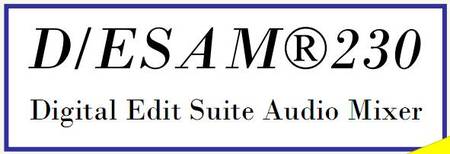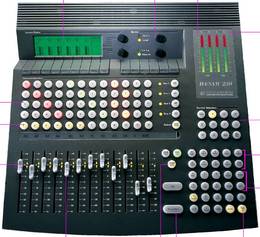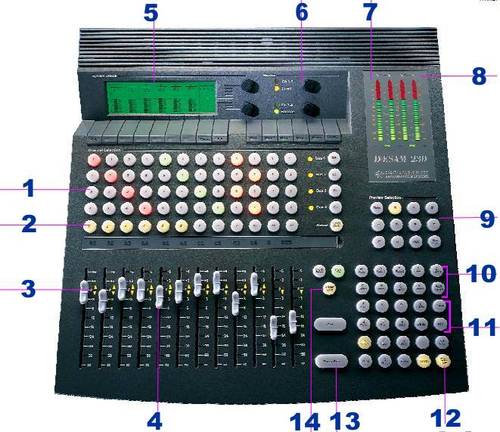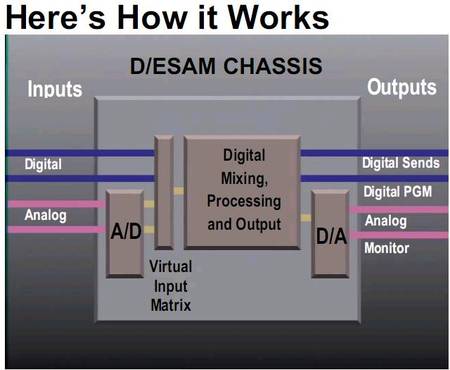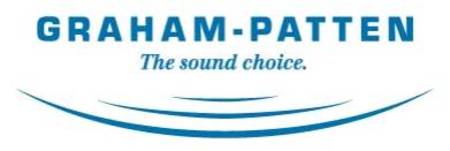Der Prospekt des D-ESAM 230, des größeren Nachfolgers
Es war eine mühsame Suche, bis ich diese 4 Seiten durch Zufall gefunden hatte.
Graham-Patten’s D/ESAM 230
.
Graham-Patten’s most cost-effective digital mixer offers powerful performance in a sleek and compact design, that integrates a control console and electronics chassis in a single table-top unit.
Like the high-end mixer models, the D/ESAM 230 offers programmable device assignments, industry-standard ESAM II and D/ESAM IV protocols, simultaneous support for both analog and digital inputs, programmable audio delay, multi-band parametric EQ, full monitoring and metering, and four digital and analog output buses.
Features now standard on the D/ESAM 230 that were once available only on the high-end D/ESAMs include send outputs, monitor sub-mixer, fader range, user configuration registers, and D/MEM write protection.
.
Analog and Digital Input Architecture
Graham-Patten’s programmable matrix architecture gives the D/ESAM 230 a wide range of control and operational capability. Logical, rather than physical, device assignments result in the units’ compact design and make dealing with modifications to the edit systems’ sources and outputs convenient.
Familiar User Interface
The D/ESAM 230 operates like a video switcher. Using Program and Preset buses, audio signals are mixed and edited in the same way video is edited. This lets video editors get up to speed fast, and become productive in the shortest possible time.
Editor Interface
Use of ESAM II and D/ESAM IV operating protocols gives the D/ESAM 230 a video switcher personality providing for intuitive operation. Editors can readily mix audio during post-production. Advanced edit controllers have implemented many extended functions of the D/ESAM protocol to facilitate operations such as remote fader level control, EQ settings, and upload/download of memory registers (D/MEM).
Expandable Architecture
The compact control panel includes all electronics and system connections for quick and easy installation. Four AES/EBU 48kHz digital inputs (eight channels) are standard, with space for two plug-in modules. These modules can be either eight channels of analog or four AES/EBU inputs (eight channels) of sample rate-converted AES digital. Users configure the system to their requirements, with room to expand in the future. This cost-effective, expandable architecture allows users to purchase either analog or digital input modules as needed.
The D/ESAM 230 (Overview)
.
(1) Output Assignment
of each fader channel may be directed to any combination of the mixer’s four output buses. The four buttons are used to select output assignment during manual operation. They provide status indicators while the mixer is under editor control. Both the Program and Preset buses utilize these illuminated buttons. Color changes indicate status. FROM sources are red; TO sources are green. When a transition or dissolve occurs, the colors change appropriately.
(2) Select Function
Each fader channel is accessed for assignment and the enabling of special functions, for example, audio processing, by pressing the select button. When a select button is illuminated, assignment and adjustments may be made to the associated fader channel. When the select function is turned off, attributes stay with the machine channel even if it is assigned to another fader. The select function may be used simultaneously on more than one fader channel.
(3) Level Offset Indicators
immediately show operators when an audio level and fader position are unmatched. This condition may occur when D/MEM registers are recalled or matching assignments are made. Offsets can be reset via a single downstroke or by using the Lock/Unlock function.
(4) High Quality 100mm Input Faders
offer the necessary tactile feedback for precise adjustment of input levels. Once set, levels may be stored in D/MEM registers and recalled. During normal operation, there is no need to continuously adjust the faders because transitions and dissolves are performed by the Program and Preset buses. Logical (soft-coded), as opposed to physical (hard-coded), machine assignments make it possible to readily group and link channels and reassign machines and tracks.
(5) System Status Display
gives operators continuous visual feedback of mixer setup and configuration. The backlit LCD screen performs all display functions necessary to install and operate the mixer – no other monitors are necessary. Soft keys and controls are used to quickly access status display menus and make changes and adjustments to built-in features like equalization, delay, and effects sends.
(6) Monitor Controls
provide instant access to the powerful four-channel preview switcher output. Independent listening level adjustment, two-channel and mono monitoring, and individual channel control are all readily accessible.
(7) 4 Channel Meter
panel gives operators level displays for each of four output busses. Signals to the meters automatically follow the output from the mixer’s internal preview switcher, monitoring
(8) Out of Phase Warning Indicators
alert operators when a channel pair is out of phase. Phase reversal can be accomplished from the mixer without patching.
(9) Preview Sources
can be selected by pushing one or more buttons. Under editor control, preview sources are switched automatically as an edit session proceeds. Mix Out switches to monitor the output of the Program bus.
(10) Transitions
are performed automatically, under editor control, or using manual control.
(11) D/MEM Register
storage and recall operations are controlled from the console or via commands from an editor.
(12) The Editor Interface
can be disabled in whole or in part when manual, or a combination of manual and editor control is desired.
(13) Manual Transitions
are performed quickly and accurately from the front panel using the buttons, or with faders set as crossfaders.
(14) Fader Split
is used to set level offsets between TO and FROM sources. This makes possible accurate and repeatable voice-overs.
D/ESAM 230 Specifications
Laut Prospekt ist das Innenleben beinahe gleich zu unserem Modell 200.
Functional
| Audio Inputs | Up to 24 input channels, analog and digital mixed |
| Machines | 10; A through H, Aux and R |
| Audio Outputs | Program: 4 Analog, 4 Digital (2 sets) |
| Monitor: 2 Analog | |
| Send: 2 Digital | |
| Equalizer | Multi-band parametric with shelving filters and notches |
| Audio Delay | 5 frames NTSC; 4 frames PAL, per mixing channel |
| Tone Generator | Internal, fixed freqency, editor and manual control |
| Phase Reversal | 180° Applied to any channel |
| Timing Input | Composite sync or video (NTSC/PAL) |
| 2 BNC (Loop-through) | |
| Sample Rate | 48kHz (NTSC/PAL) locked to TV field |
| Transition Rates | 0 - 999 Frames |
| Transition Resolution | Field accurate, 1500 steps per second |
| D/MEM Registers | Standard: 40 D/MEM Registers plus 5 user |
| configurations, battery back-up | |
| Editor Protocol | ESAM II and D/ESAM IV |
| Meters | 4 Channel VU or PPM LED 28 segment bargraph |
| with adjustable peak indicators |
Performance
| Accuracy | Internal audio data transfers: 24 bit precision |
| Internal calculations: 56 bit precision | |
| Analog Program Outputs | |
| Coupling | DC - Active balanced |
| Source Impedance | <30 Ohm |
| Level | +22dBu max, into 600Ohm or greater |
| S/THD+N @ -20 dBFS: | >70dB |
| S/THD+N @ 0 dBFS: | >90dB |
| Signal to Noise | >100dB @ Digital silence |
| Frequency Response | ± 0.1dB 20-20kHz |
| ± 0.05dB 50-15kHz (Typical) | |
| Crosstalk @ 0 dBFS: | >94dB @ 1kHz |
| Digital Program Outputs | |
| Number | 2 Outputs: Program 1&2 (AES Digital Format, 20/24 bit) |
| 2 Outputs: Program 3&4 (AES Digital Format, 20/24 bit) | |
| Digital Send Outputs | |
| Number | 1 Output: Program 1&2 (AES Digital Format, 20 bit) |
Physical
| Audio Connectors | Analog (XLR or ¼" phono jack), Digital (BNC) |
| Interface Connectors | Serial 9-pin D sub-min (RS-422) |
| Dimensions | |
| Control Panel / | 16.875" (42.86 cm) Wide x 16.25" (41.28cm) Deep |
| Electronic Chassis | Unit is 5.5" (13.97cm) High at rear, 1" (2.54cm) at front |
| Allow 2" (5.08cm) for cabling at rear | |
| Power | |
| Voltage Requirements | 100 - 240 VAC |
| Frequency | 50 - 60 Hz |
| Power Consumption | 50 Watts |
| Operating Temperature | 10 - 40°C |
| Note: | 0dBFS = digital clipping |
| 0dBu = 0.775V rms |
Here's How it Works
The D/ESAM 230 base system includes 4 AES/EBU 48kHz digital (Stereo-) inputs (8 channels). Additional input modules, each with eight channels, analog or sample rate converted digital, can be easily plugged into the system for a total of 24 input channels. Analog modules digitize incoming audio and convert that signal to the D/ESAM mixer's internal data format. Digital audio is formatted for the internal data format with sample rate conversion applied if that type input module is installed.
With all signals in a common internal data format, the main processor section performs mixing, switching, and audio signal processing in a single data stream. The latest in DSP and microprocessor technology is employed to deliver the greatest possible long-term performance and value.
Four digital program, four analog program, two digital sends, and the four monitor channels are provided by the mixer's output. The monitor channels are internally summed to two analog outputs for connection to the user-supplied stereo power amplifier and speakers. An additional set of the four digital program channels is provided for connection to a second record VTR or elsewhere in the edit suite.
.
Die Anschrift (ab 2004 nicht mehr gültig)
GRAHAM-PATTEN
The sound choice.
119 East McKnight Way, Unit A,
Grass Valley, California 95949
Phone: 530-477-2984
Toll Free: 888-622-4747
Fax: 530-477-2986
E-mail: info@isis-group.com
Website: www.gpsys.com
- Auch Telefon und Internet sowie e-mail sind natürlich schon lange offline. Die Domains stehen sogar in 2020 noch zum Verkauf an. Das zeigt ganz deutlich die Vergänglichkeit von technischen Entwicklungen.
.

